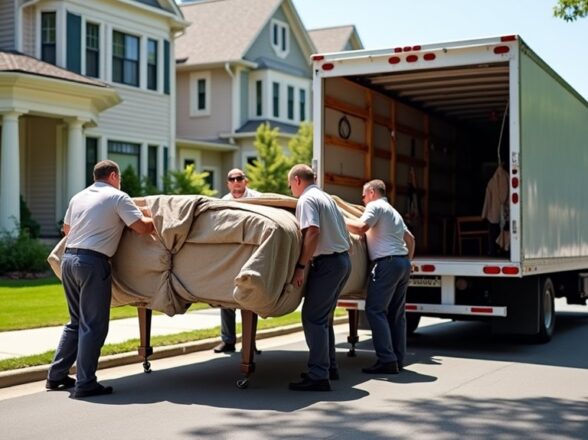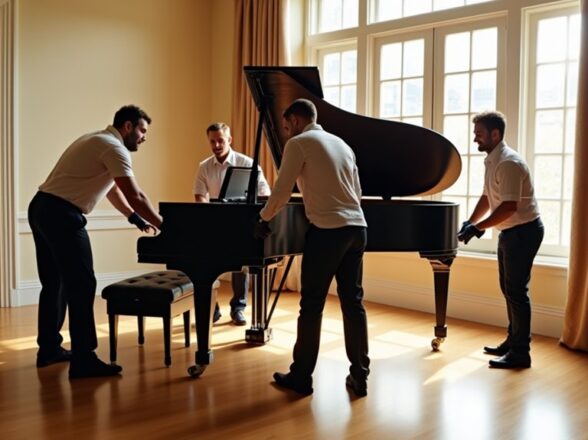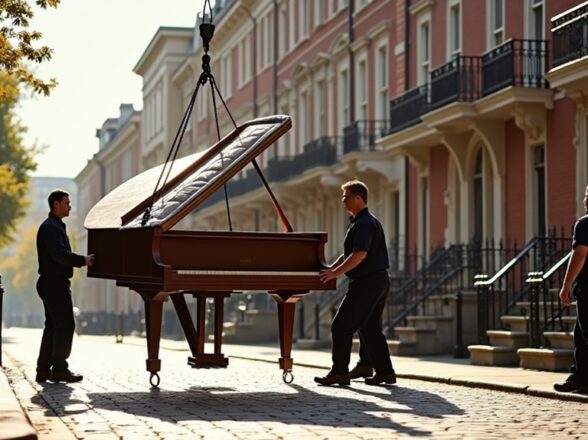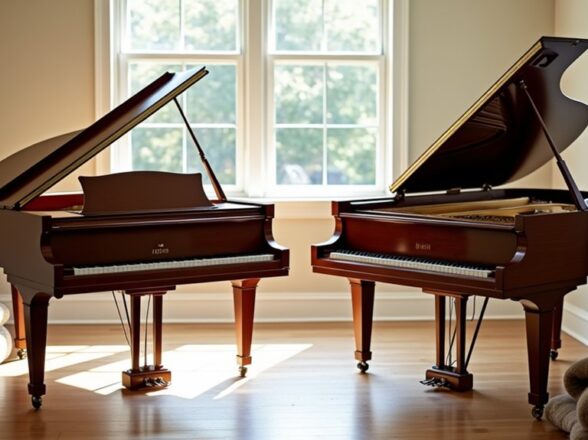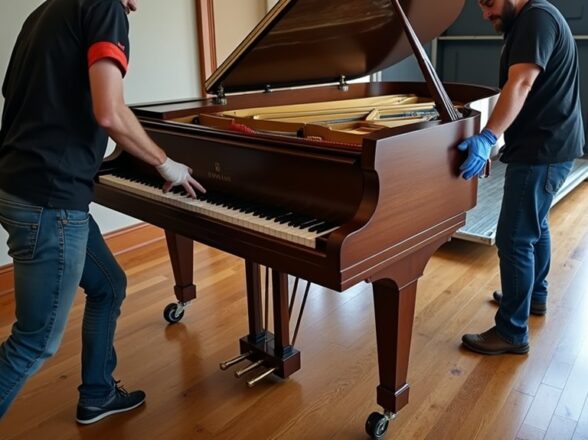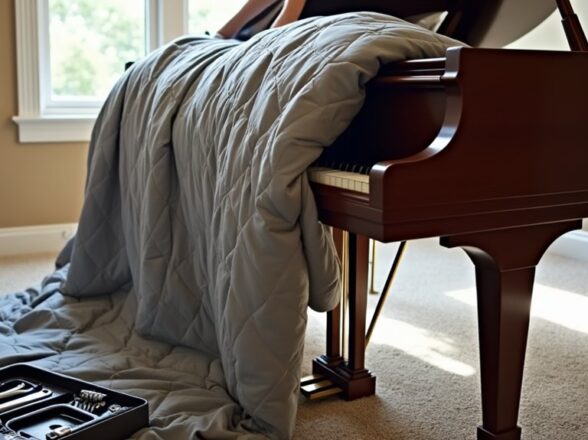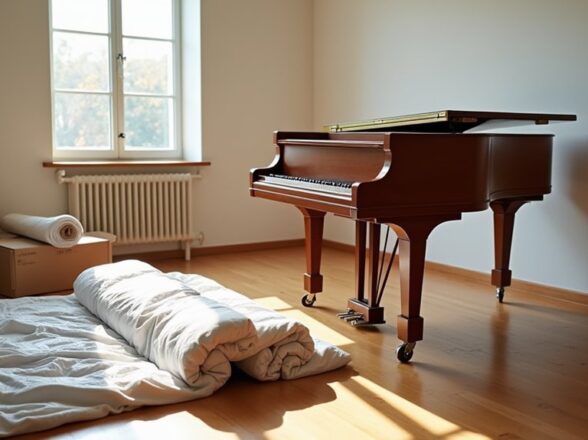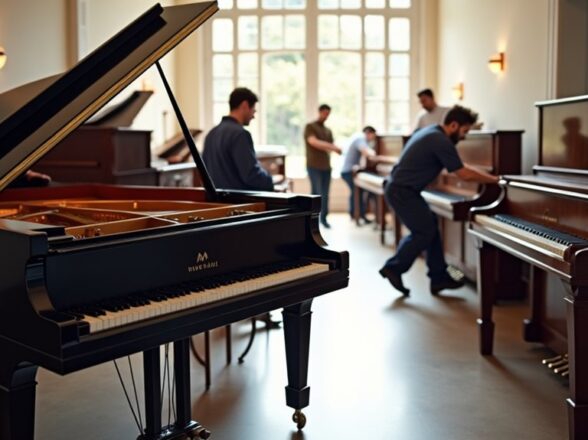How to Move a Piano Safely for Concerts and Events? Special Considerations for Professional Performances

To move a piano safely for concerts and events, start by evaluating the type of piano you have and gathering the right tools like a piano dolly, straps, and blankets. Plan your route, checking doorway widths and evaluating any obstacles. When loading, secure the piano properly to prevent shifting during transport. Verify the venue has adequate space and that the piano's placement enhances sound quality. After moving, inspect the piano for damage and make necessary adjustments like tuning. Proper handling is essential to maintain the instrument's condition, and there are more details you can explore to enhance your approach.
Key Takeaways
- Assess the piano type and size to determine the appropriate moving techniques and equipment needed for safe transportation.
- Use proper lifting techniques and tools like dollies, straps, and blankets to secure the piano during the move and protect its surface.
- Plan the route carefully, checking doorway widths, hallway spaces, and potential obstacles to ensure smooth navigation to the venue.
- Position the piano strategically at the venue to enhance acoustics and avoid sound muffling, ensuring accessibility for performers and audience.
- Conduct a post-move inspection and schedule tuning to ensure the piano remains in optimal condition for the performance.
Assessing the Piano Type

When it comes to moving a piano, knowing the type you're dealing with is vital. Different piano types, such as uprights and grand pianos, require distinct handling approaches. Upright pianos are generally smaller and easier to maneuver, but they still need careful support to prevent damage. In contrast, grand pianos are larger and heavier, often requiring more planning due to their shape and weight distribution. Acoustic considerations also play a role, as these instruments can be sensitive to temperature and humidity changes during transportation. Understanding your piano's specific characteristics helps guarantee a safe move. Always assess its size, weight, and construction materials to make informed decisions about the moving process. Engaging a team with specialized equipment ensures safe and efficient transport of your instrument. This knowledge is essential for a successful and secure relocation.
Choosing the Right Equipment
When moving a piano, having the right equipment is vital for safety and efficiency. You'll need essential moving tools like a dolly, straps, and blankets to protect the instrument. Additionally, using proper lifting techniques can help prevent injury and damage during the move.
Essential Moving Tools
Moving a piano isn't just about muscle; it's also about having the right tools at your disposal. To guarantee a safe and efficient move, consider these essential items:
- Moving Blankets: These protect the piano's surface from scratches and damage during transport. Wrap the piano securely before moving it.
- Piano Dollies: Use a sturdy piano dolly to make moving easier. These specialized dollies are designed to support the weight and size of the instrument.
- Straps: Employ heavy-duty straps to secure the piano on the dolly. This prevents any shifting and keeps it stable while you maneuver through tight spaces.
Having the right equipment will help you avoid accidents and protect the piano throughout the moving process.
Proper Lifting Techniques
To guarantee a safe piano lift, you need to prioritize proper techniques and the right equipment. Start by ensuring your lifting posture is correct. Stand with your feet shoulder-width apart, bend your knees, and keep your back straight. This will help you lift with your legs rather than your back, reducing the risk of injury. It's also essential to establish good team coordination. Communicate clearly with your team members about the lift and the direction you'll move. Designate a leader to call out commands, so everyone is synchronized. Use tools like dollies or straps to assist with lifting and moving. Always remember that safety is the top priority, so don't rush the process.
Planning the Route

Before you start moving the piano, you need to plan your route carefully. Look at the layout of the venue to see how you'll navigate through different spaces. Identifying any obstacles like stairs or narrow doorways will help you avoid problems during the move.
Assessing Venue Layout
Planning the route for your piano move requires careful thought of the venue layout. Understanding the venue space and its layout dynamics is essential for a smooth process. Start by identifying the main entry points and paths you'll need to use. Here are three key factors to take into account:
- Width of Doorways: Verify the piano can fit through all doorways along the route.
- Hallway Space: Check the width and length of hallways to avoid tight spots.
- Surface Types: Note the flooring, as some surfaces may require special handling or tools.
Identifying Obstacles Ahead
Once you've assessed the venue layout, it's time to pinpoint any obstacles that might impede your piano move. Start by identifying hazards like stairs, narrow doorways, and uneven surfaces. These obstacle types can complicate your path, so take note of them. Make certain you have the right equipment to navigate these challenges, such as ramps or dollies. Check for low-hanging lights or decorations that could obstruct your movement. It's also wise to observe the floor for slippery spots or clutter that could pose a risk. By thoroughly identifying these hazards ahead of time, you can plan an efficient and safe route for transporting the piano. This proactive approach helps you avoid delays and makes certain a smooth setup for your performance.
Preparing the Venue
Preparing the venue for a piano move is essential for a smooth process. You need to guarantee that the space is ready to accommodate the piano safely and efficiently. Here are three key areas to focus on:
- Venue Accessibility: Check that entrances, hallways, and loading areas are clear and wide enough for the piano. This prevents delays and potential damage during the move.
- Sound Considerations: Consider the acoustics of the venue. Placement of the piano can considerably impact sound quality during the performance, so choose a spot that enhances the music.
- Floor Protection: Protect the floor where the piano will be moved to avoid scratches or damage. Use mats or boards to distribute the piano's weight evenly.
Disassembling the Piano

Before you start moving the piano, it's crucial to disassemble it properly to guarantee a safe transport. Use piano disassembly techniques to remove any detachable parts, like the legs and pedals. Start by carefully unscrewing the legs, ensuring you keep all screws and parts in a labeled bag for easy reassembly later. Next, take off the pedals by loosening any fasteners. This reduces weight and makes it easier to maneuver. Always use protective measures, such as blankets or padded covers, to shield the piano's surfaces from scratches or dents during the disassembly process. Taking these steps not only protects the instrument but also makes it more manageable for transport, ensuring a smoother move to your event.
Loading and Securing
Loading the piano onto the moving vehicle is a critical step that requires careful attention. You need to guarantee proper load distribution to prevent damage during transit. Follow these steps to load and secure the piano effectively:
- Position the Piano: Place the piano on a dolly, guaranteeing it's balanced and securely supported.
- Use Securing Mechanisms: Utilize straps or tie-downs to fasten the piano to the vehicle. Make sure they are tight but not overly constricting.
- Check Stability: Before driving, double-check that the piano is stable and won't shift during transport.
Navigating Stairs and Tight Spaces

Traversing stairs and tight spaces can be one of the most challenging aspects of moving a piano, especially if you're not prepared. To navigate these obstacles effectively, use proper piano dolly techniques and staircase strategies.
| Technique | Description |
|---|---|
| Use a Piano Dolly | A dolly helps in rolling the piano and balancing its weight. |
| Securely Position Helpers | Have one person in front and one behind to guide and stabilize. |
| Tilt and Slide on Stairs | Carefully tilt the piano while sliding it up or down steps. |
For a smooth transition, consider employing comprehensive solutions offered by professional movers to ensure the piano's safety and minimize disruptions during the moving process.
Setting Up at the Venue
After successfully maneuvering stairs and tight spaces, the next step is setting up the piano at the venue. You need to take into account a few key factors to guarantee the best performance.
- Venue Acoustics: Place the piano in a spot where the sound carries well. Avoid corners and walls that might muffle the sound.
- Lighting Considerations: Make sure the piano is well-lit but avoid direct light that could cause glare on the keys.
- Stable Surface: Set the piano on a flat and stable surface to prevent any movement during play.
Post-Move Maintenance

Once you've successfully moved the piano, it's essential to focus on post-move maintenance to guarantee it remains in peak condition. First, conduct a thorough post-move inspection. Check for any visible damage to the exterior and verify all keys function properly. Next, assess the piano's tuning. Moving can disrupt the internal components, leading to a need for piano tuning. Schedule a professional tuner to restore the sound quality and balance. Additionally, monitor the piano's environment; keep it away from direct sunlight and drafty areas. Regularly clean the exterior with a soft cloth to prevent dust buildup. By taking these steps, you'll help maintain the piano's performance and extend its lifespan for future concerts and events.
Frequently Asked Questions
How Can I Determine if My Piano Is Too Heavy to Move Alone?
To determine if your piano's too heavy to move alone, conduct a weight assessment. If you struggle lifting it or can't maneuver with moving tools, it's time to call for assistance to guarantee safety.
What Insurance Options Are Available for Moving a Piano?
Moving a piano's like steering a tightrope; you need balance. Consider piano insurance for protection against damage. Look for liability coverage too, ensuring you're covered for accidents during the transport. Always check your options before moving!
Should I Hire Professional Movers or Attempt to Move It Myself?
You should hire professional movers because a piano's weight can be intimidating. They have the right moving equipment and experience to handle the logistics, ensuring your instrument arrives safely without risking damage or injury.
How Do I Protect the Piano During Transportation?
To protect the piano during transportation, use thick piano padding to cover all surfaces. Then, secure it with strong straps to prevent movement. Make sure it's snug and stable for a safe journey.
Are There Specific Regulations for Moving Pianos in Public Spaces?
You'll need to check local public safety regulations and obtain venue permissions before moving a piano. Understanding these requirements guarantees you comply with laws, keeping both the instrument and the audience safe during transport.
Conclusion
Moving a piano for concerts and events requires careful planning and execution. Many believe that any strong person can do it, but this isn't true. Proper techniques and equipment are essential to avoid damage and injury. By evaluating the piano type, choosing the right tools, and preparing the venue, you increase the chances of a successful move. Remember, a well-planned process guarantees the piano arrives safely, allowing the performance to shine without worry.
Related posts
Recent posts
Post Categories
Tags
Subscribe

